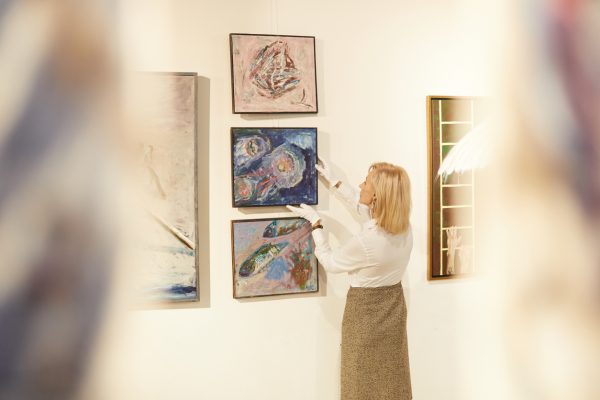A report published by the Arts Council in 2018 found that 68% of artists in the UK supplement their practice with additional employment, and many artists recommend developing alternative income streams to support your creative work. Whether you’re looking for a 9-to-5 position or more flexible roles, the art world can offer many opportunities for artists to use their creative skills and connect with others whilst earning additional income.
Framing

Framing requires practical skills and aesthetic judgement, both areas in which artists excel. In an art market fuelled by a constant stream of exhibitions and art fairs, good framers can find themselves with a steady supply of work from commercial galleries, in addition to museums and private clients. With an average annual salary of £19,500, framing is not necessarily the most lucrative of careers, but salaries do rise with experience. Although some colleges offer courses in framing, most working in the trade learn their craft through on-the-job training.
Art handling
It’s an art world cliché that every news story for a multi-million-pound auction sale must be accompanied by white-gloved art handlers pretending to lift a precious painting, but handlers undoubtedly play a vital role in both the commercial and museum sectors. Art handling requires strength, caution, and nerves of steel when carrying fragile works of art, but for the art world it offers a relatively high average salary of just over £25,000 per year. It can also offer travel opportunities, with many blue-chip galleries taking their in-house team to set up international art fairs. As with framing, art handling does not require specific qualifications, and roles can be offered by art shipping companies, auction houses, museums, and commercial galleries.

Gallery administration
The road from an artist’s studio to a client’s home can be a long one, and the many logistical requirements of holding exhibitions ensure that most art dealers employ gallery managers and assistants. Gallery managers are usually an art dealer’s second-in-command, overseeing the smooth running of a gallery and its programme of events to allow its owner to focus on relationships with clients and artists, making this a high-responsibility role that is rarely part-time.
Depending on the gallery, an assistant’s role may be equally fast paced, but can involve more specific tasks and fewer responsibilities, which is reflected in the difference in average salary between a gallery manager (around £34,000 per year in the UK) and assistant (just over £19,000 per year). Gallery assistant roles offer an excellent insight into the commercial world for artists, and are occasionally part-time. Competition for vacancies can, however, be fierce, particularly within London, and many gallery assistants have undergraduate and MA degrees in art history, in addition to undertaking unpaid internships prior to gaining their first paid position.
As available roles in commercial galleries are not always advertised, it can be worth sending speculative applications via email.
Public institutions and museums
Outside of the commercial art world, many non-profit organisations such as public art spaces also offer administration roles, which require similar skills without being sales focused. Many small institutions rely on volunteers to invigilate exhibitions, but some do offer paid invigilation and customer service roles, particularly in larger galleries and museums. Vacancies in publicly funded organisations are often listed on the Arts Council website.
Tutoring

For those passionate about art, tutoring offers an excellent opportunity to share your knowledge and skills. Teaching roles in UK state schools require an undergraduate degree and a teacher training qualification such as a PGCE, but private schools are not legally obliged to employ teachers with specific qualifications. Although unquestionably entailing their own challenges, teaching roles are well paid, with an average UK salary of over £35,000, and government grants and loans are available for those wishing to undertake teacher training.
Alternatively, artists can offer private tuition on a freelance basis, charging students an hourly rate or a set fee for a course. (Those planning to offer courses for children may wish to undertake a Disclosure and Barring Service Check.) Courses could take place in person, in your studio if space allows, or virtually, with many websites now offering artists a platform to sell pre-recorded training videos, such as Skillshare and Udemy. While you might be able to charge higher rates for in-person classes, video courses offer the opportunity to reach a wider, global audience, and the potential for future passive income, with the average tutor on Skillshare earning US$200 per month.
Which freelance skills are in demand in the art world?
In a highly visual industry, the strength of a gallery’s marketing lies at the root of its success, and the art world draws upon the skills of a large network of freelance contractors, including photographers and graphic designers. Many of the skills which artists develop to market their own work can be invaluable to galleries, such as social media management, and sound and video artists are perfectly placed to help galleries produce promotional videos or podcasts. As with gallery administration roles, speculative pitching could potentially lead you to freelance opportunities that can supplement and support your artistic practice.







